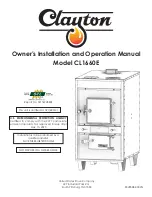
29
To ensure proper unit grounding, an earth ground wire must be connected between the furnace ground screw located inside
the furnace junction box and the electrical service panel.
NOTE:
Do not use gas piping as an electrical ground. To confirm
proper unit grounding, turn off the electrical power and perform the following check.
1. Measure resistance between the neutral (white) connection and one of the burners.
2. Resistance should measure 10 ohms or less.
This furnace is equipped with a blower door interlock switch which interrupts unit voltage when the blower door is opened for
servicing. Do not defeat this switch.
24 V
OLT
T
HERMOSTAT
W
IRING
When installed with a non-communicating thermostat, the fur-
nace integrated control module provides terminals for both “W1”
and “W2”, and “Y1” and “Y2” thermostat connections. This allows
the furnace to support the following system applications: ‘Two-Stage
Heating Only’, ‘Two-Stage Heating with Single Stage Cooling’, and
‘Two-Stage Heating with Two-Stage Cooling’. Refer to the following
figures for proper connections to the integrated control module.
Low voltage connections can be made through either the right or left
side panel. Thermostat wiring entrance holes are located in the blower
compartment. The following figure shows connections for a “heat/
cool system”.
This furnace is equipped with a 40 VA transformer to facilitate use
with most cooling equipment. Consult the wiring diagram, located
on the blower compartment door, for further details of 115 Volt and
24 Volt wiring.
NOTE:
Use of cooling ramping profiles and dehum feature re-
quires a jumper between Y1 and O when a straight cooling unit
is used.
The auxiliary contacts are shipped with a factory installed jumper.
As an option, the auxiliary contacts may be wired to a normally
closed float switch. In the event of open contacts, the gas heat
and cooling will be disabled until the condition is corrected.
These are 24 volt terminals powered internally, do not apply
another voltage source to these terminals.
-
HEAT SET-UP DIP SWITCH
DIP
SWITCH
#13 MUST
BE
SET
TO
MATCH
THERMOSTAT
TYPE
. T
O
USE
THE
CTK01
COMMUNICATING
THERMOSTAT
, DIP
SWITCH
#13
MUST
BE
SET
TO
ON
POSITION
. T
HIS
IS
ALSO
THE
CORRECT
SETTING
FOR
A
NON
-
COMMUNICATING
2-
STAGE
THERMOSTAT
. T
O
USE
CTK02**, CTK03**
OR
CTK04**
MODULATING
THERMOSTAT
,
CHECK
TO
MAKE
SURE
DIP
SWITCH
#13
IS
IN
THE
OFF
POSITION
(
FACTORY
POSITION
). T
HIS
IS
ALSO
THE
CORRECT
POSITION
WHEN
USING
A
NON
-
COMMUNICATING
SINGLE
-
STAGE
THERMOSTAT
.
IMPORTANT NOTE
T
HERMOSTAT
“R”
REQUIRED
IF
OUTDOOR
UNIT
IS
EQUIPPED
WITH
A
C
OMFORT
A
LERT
™
MODULE
OR
IF
THE
OUTDOOR
UNIT
IS
A
PART
OF
THE
C
OMFORT
N
ET
™
FAMILY
OF
EQUIPMENT
.
IMPORTANT NOTE
AUX
DE
HUM
W2
C
1
Y1
2
R
W1
Y2
G
O
24 V THERMOSTAT CONNECTIONS
Low Voltage Connections with Auxiliary Terminals
Figure 30
W
IRE
ROUTING
MUST
NOT
INTERFERE
WITH
CIRCULATOR
BLOWER
OPERATION
,
FILTER
REMOVAL
OR
ROUTINE
MAINTENANCE
.
A
REMOVABLE
PLUG
CONNECTOR
IS
PROVIDED
WITH
THE
FURNACE
CONTROL
TO
MAKE
THERMOSTAT
WIRE
CONNECTIONS
. T
HIS
PLUG
MAY
BE
REMOVED
,
WIRE
CONNECTIONS
MADE
TO
THE
PLUG
,
AND
REPLACED
. I
T
IS
RECOMMENDED
THAT
MULTIPLE
WIRES
BE
JOINED
WITH
A
WIRE
NUT
AND
A
SINGLE
CONDUCTOR
BE
INSERTED
UNDER
THE
TERMINAL
SCREW
. F
AILURE
TO
DO
SO
MAY
RESULT
IN
INTERMITTENT
OPERATION
.
STRONGLY
















































